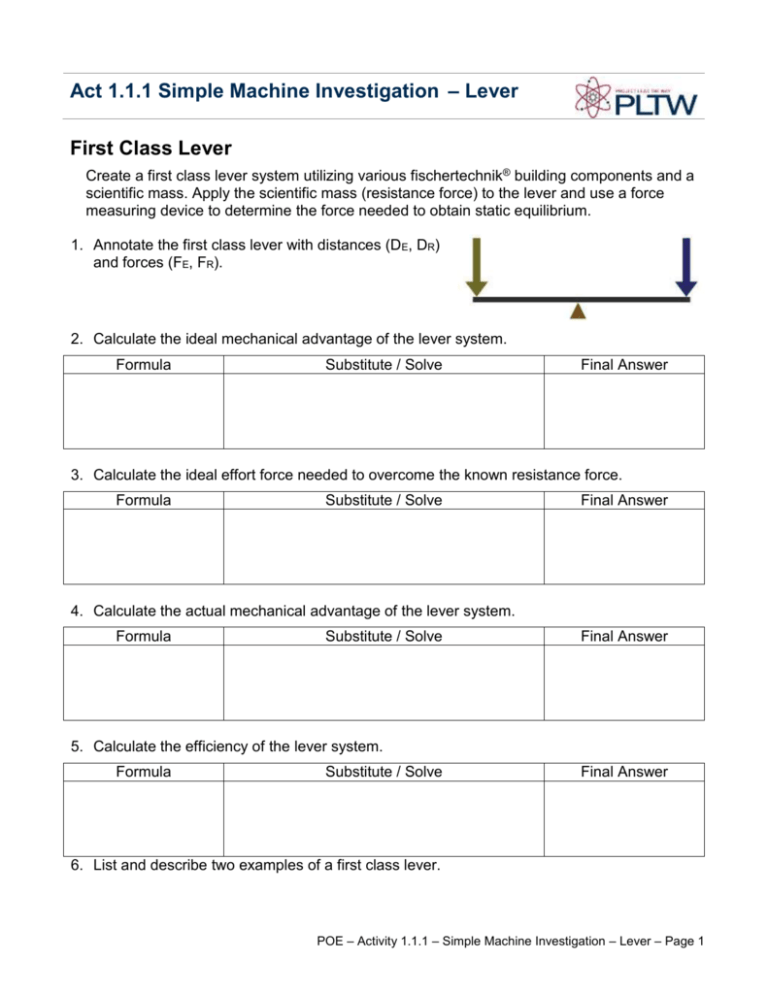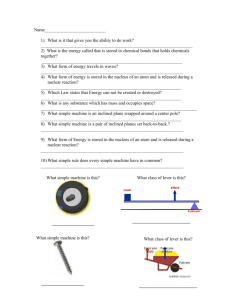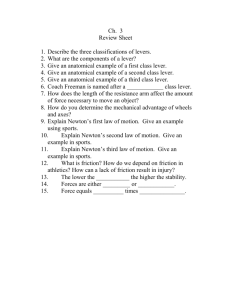Activity 1.1.1 Simple Machine Investigation * FT
advertisement

Act 1.1.1 Simple Machine Investigation – Lever First Class Lever Create a first class lever system utilizing various fischertechnik® building components and a scientific mass. Apply the scientific mass (resistance force) to the lever and use a force measuring device to determine the force needed to obtain static equilibrium. 1. Annotate the first class lever with distances (DE, DR) and forces (FE, FR). 2. Calculate the ideal mechanical advantage of the lever system. Formula Substitute / Solve Final Answer 3. Calculate the ideal effort force needed to overcome the known resistance force. Formula Substitute / Solve Final Answer 4. Calculate the actual mechanical advantage of the lever system. Formula Substitute / Solve Final Answer 5. Calculate the efficiency of the lever system. Formula Substitute / Solve Final Answer 6. List and describe two examples of a first class lever. POE – Activity 1.1.1 – Simple Machine Investigation – Lever – Page 1 Second Class Lever Create a second class lever system utilizing various fischertechnik® building components and a scientific mass. Apply the scientific mass (resistance force) to the lever and use a force measuring device to determine the force needed to obtain static equilibrium. 1. Annotate the second class lever with distances (DE, DR) and forces (FE, FR). 2. Calculate the ideal mechanical advantage of the lever system. Formula Substitute / Solve Final Answer 3. Calculate the ideal effort force needed to overcome the known resistance force. Formula Substitute / Solve Final Answer 4. Calculate the actual mechanical advantage of the lever system. Formula Substitute / Solve Final Answer 5. Calculate the efficiency of the lever system. Formula Substitute / Solve Final Answer 6. List and describe two examples of a second class lever. POE – Activity 1.1.1 – Simple Machine Investigation – Lever – Page 2 Third Class Lever Create a third class lever system utilizing various fischertechnik® building components and a scientific mass. Apply the scientific mass (resistance force) to the lever and use a force measuring device to determine the force needed to obtain static equilibrium. 7. Annotate the third class lever with distances (DE, DR) and forces (FE, FR). 8. Calculate the ideal mechanical advantage of the lever system. Formula Substitute / Solve Final Answer 9. Calculate the ideal effort force needed to overcome the known resistance force. Formula Substitute / Solve Final Answer 10. Calculate the actual mechanical advantage of the lever system. Formula Substitute / Solve Final Answer 11. Calculate the efficiency of the lever system. Formula Substitute / Solve Final Answer 12. List and describe two examples of a third class lever. POE – Activity 1.1.1 – Simple Machine Investigation – Lever – Page 3 13. Is it possible for a first or second class lever to have a mechanical advantage less than one, or for a third class lever to have a mechanical advantage greater than one? Justify your answer. 14. When you were solving for mechanical advantage, what units did the final answer require? Explain why. POE – Activity 1.1.1 – Simple Machine Investigation – Lever – Page 4








